I am very encouraged today. A little elated, actually. Yesterday, John Powell and I met with seven members of the Help-U-Sell family in San Diego and Riverside Counties. Our conversation was free-wheeling but seemed to focus mostly on marketing and deal-doing strategies. As we got into the realm of Short Sales I had to sit back, and I started to smile to myself. These guys, the survivors, know their stuff!
Short Sales are complicated things. There are dozens of lenders, each with their own requirements, varying industry and government regulations to consider as well as the vagaries of investors on the secondary market. To work them and work them in a way that makes them worthwhile, there is a huge volume of information a real estate professional must know and manage. The level of detail, understanding and street-wise know how I heard when these folks talked about what they’re doing was astounding.
It took me WAY BACK (I mean, way WAY BACK) to 1982, when interest rates edged close to 17% and the only way you survived was by knowing financing, contracts, and sales strategies inside and out. We called it ‘creative financing,’ but it was really just knowing your business so well you could make things happen even under impossible circumstances. It was a great time to be a REALTOR, a time of pride, because you knew if the person sitting across the table from you had a REALTOR pin on their lapel and an HP 12-C calculator cranked up, he or she was probably just as smart as you and the two of you were going to put that deal together.
The boom years were a fun ride, like the latest offering at Six Flags. But, like that Six Flags ride, the pace was fast and the lines of people pressing to get in on the good thing were long. Few practitioners took the time to learn their business. Most just gripped the safety bar and screamed. We (as an industry) got dumber and dumber. It was almost cartoon comical . . .
Picture the agent and buyer standing outside the house that’s just been toured. The buyer says, ‘So, if I put 20% down, what would my payment be on a 30 year fixed?’ The agent hems and haws, scratches his head and finally answers, ‘I don’t know . . . let me call my lender.’ That was 2005.
In the churning and collapse of our markets, the weaker ones, the ones who didn’t learn how to put a and b together to make c, fell by the wayside. They didn’t have the depth of knowledge they needed to make it through this mess. That’s why the ranks of REALTORS across the country are way down. The survivors are a wonderful bunch of very sharp people. Many are hanging on by their wits and their toenails waiting for the wheel to turn but from what I see, their grip is tenacious and they will make it around that bend.
Suddenly, the REALTOR is a hero again.

